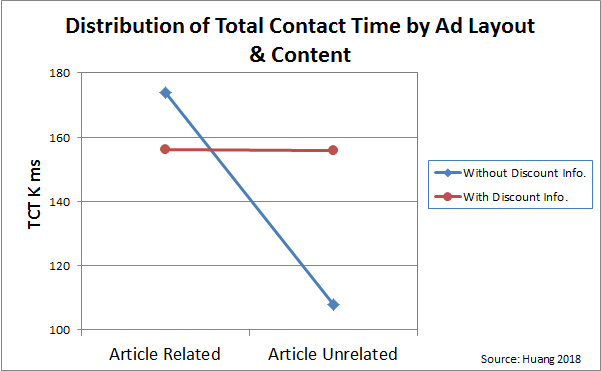With the rapid growth of online advertising, viewer attention is becoming increasingly scarce. In 2018 alone, total media ad spending will rise 7.4% to $638 billion. Digital media will account for 43.5% of this total ad spend (eMarketer 2018) and will surpass conventional advertising by 2021. With online browsers bombarded with more and more advertising the trick is to capture their limited attention with compelling ads. This article summarizes a study that examined the attention that female consumers paid to product-based personalized banner ads for online apparel retailers (Huang 2018).
Using a screen eye tracker, the researchers tested the effects of ad slot position and content composition of personalized banner ads on eye movement data. The study found that placing banner ads next to relevant articles increases the overall attention that female consumers give the ad. Ads in the top-center slot received greater total contact time and number of fixations than those in the right sidebar. The reserchers also found that adding discount information and using models to display the apparel in banner ads increases the total contact time and number of fixations.
Interestingly, ads that contained discount information were nearly immune from the drop in attention seen when non-discounted ads were placed near non-relevant articles.
Personalized Ads & Retargeting
To combat “banner blindness” where users routinely ignore banner ads online, advertisers are adopting personalized banner ads to increase clickthrough rates. Personalized advertising arose out of technologies that allowed tracking user behavior on the Internet. Personalized ads have been shown to be more effective in capturing viewer attention.
In the recent past, personalized banner ads have utilized consumers’ past Internet activity. By tracking what users bought or browsed, advertisers can target product-based ads to retarget the consumer. Retargeting displays relevant ads to consumers who expressed interest in a product or service, but did not complete the sale. Retargeting gives advertisers another chance at making the sale.
Influence of Banner Ad Composition on Attention
To study the effect of different banner ad composiition and slot position the researchers conducted an eye tracking experiment. They placed banner ads with different layouts and content in the right sidebars of pages featuring articles related and unrelated to apparel as well as in the top center slot. The goal was to determine the influence of ad layout (top or sidebar) and ad content (with or without discount information and models) on user attention with and without content relevance.
The most striking results of the study were that females paid more attention to the inclusion of discounts in banner ads (see Figure 1).
In fact, including discount information in the apparel banner ads made the ads attract nearly as much attention when placed next to unrelated articles than related. Ads without discount information received significantly less attention next to unrelated articles than related. Ads that featured models garnered more attention than ads without models.
Conclusion
With the boom in online advertising retailers are competing for scarce viewer attention. Advertisers are combating dropping CTR with personalized advertising and retargeting. This eye tracking study found that females pay more attention to banner ads with discounts and models.
Further Reading
- eMarketer Releases New Global Media Ad Spending Estimates
- Total media ad spending will rise 7.4% to $638 billion in 2018, according to eMarketer. Digital media will account for 43.5% of total spend ($274.39 billion) thanks to the rise of ecommerce spending and viewers shifting from traditional TV to digital. By 2020, digital will near 50% of total advertising spend.
- “The female gaze: Content composition and slot position in
personalized banner ads, and how they influence visual attention in
online shoppers” - This study examined the attention that female consumers paid to product-based personalized banner ads for online apparel retailers, and how this attention was influenced by banner ad placement and content. Researchers at the Department of Commercial Design, Chung Yuan Christian University in Taiwan found that the presence of discount information and models in apparel ads increased attention.
Huang, Y. Computers in Human Behavior 82 (2018) 1-15.

